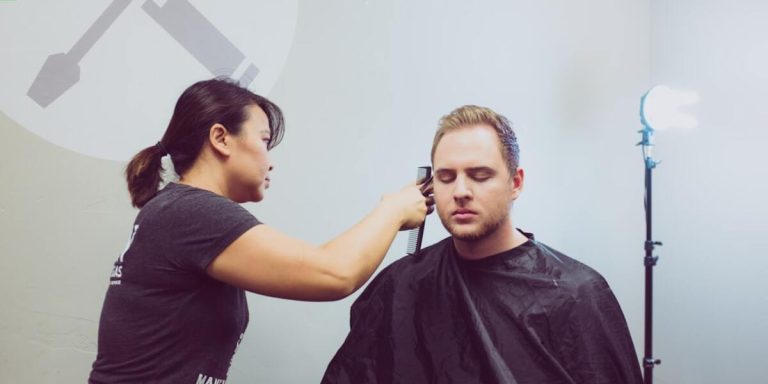Low Porosity Hair Care Routine: A Comprehensive Guide for Healthier Hair
Understanding your hair porosity can drastically change the game in managing and caring for beautiful, healthy locks. The “low porosity hair care routine” is specially designed for those who have experienced their hairs’ stubborn resistance to moisture penetration. With a correct understanding of what low porosity means and how it affects daily routines, individuals will be armed with handy tips ensuring effective maintenance strategies.
Navigating through the world of natural hair types may seem overwhelming but getting familiar with terms like ‘hair porosity’ proves extremely beneficial. Essentially, having low porous tresses implies that your cuticles lie flat causing them to repel water when you try wetting it; giving birth to various issues like dryness or product buildup on your scalp. Therefore, tuning into an appropriate low-porosity regimen becomes invaluable to maintain healthier strands!
Did you know?
Did you know? Low porosity hair has compact cuticles that resist moisture intake, making it harder for water and oils to penetrate the hair strands. Special care methods like steam treatment or using lighter oils can greatly enhance its health.
Understanding Low Porosity Hair: Characteristics and Challenges
Low porosity hair is a unique type that can be somewhat challenging to manage. Affected strands are tightly packed with closed cuticles, inhibiting the absorption of moisture and nutrients. If this sounds like your mane struggle in 2023, you’re not alone—many individuals grapple daily with keeping their low porosity locks hydrated and healthy.
Now, although it may seem daunting at first glance, understanding these characteristics arms you for better hair care practices. Think about it: if water has difficulty penetrating your hair shafts due to excessively flat cuticles (a quintessential feature of low porosity), then common moisturizing strategies might prove futile from the get-go! It’s all about working knowledgeably with what you have rather than against it.
The larger challenge manifests when attempting unfamiliar methods or using inappropriate products on such hairs―an unfortunate scenario many fall into due to lack of information or misguidance. To navigate this hurdle requires an effective routine specifically tailored towards nourishing and maintaining low porosity tresses – which we’ll explore further as we continue our journey through Hair Care & Maintenance topics here at Soulphany.
Defining Hair Porosity: What Makes Low Porosity Unique?
Porosity, a term you might often come across in your hair care routine discussions, plays an integral role in determining the health and appearance of your tresses. When we speak about “hair porosity,” it simply refers to how well your hair can absorb and retain moisture.
Defining low-porosity? Well, imagine a tightly compacted roof; that’s exactly what the outer covering (cuticle layer) of low-porositic hairs looks like! These strands have closed cuticles making it hard for water or products to penetrate inside easily thus leading them towards dryness if not accurately taken care of.
What makes these particularly unusual are their stubborn nature when dealing with products or treatments aimed at hydration or nourishment. In simple terms – anything designed for conditioning gets tricky because primarily they don’t let anything seep through!
The challenge here lies effective penetration without causing damage—making implementing a specially designed ‘Low Porosity Hair Care Routine’ vital for healthy-looking locks by 2023 standards.
Overcoming Common Struggles with Moisturizing Low Porosity Hair
When it comes to moisture retention, low porosity hair often presents a challenge. However, with the right care routine tailored for this specific hair type, overcoming these hurdles is possible.
Firstly, we have to understand that low porosity strands don’t easily absorb moisture due their tightly packed cuticles. This might cause your locks to feel dry and brittle despite numerous attempts at hydrating them.
So what’s the secret solution here? The keyword you need in your arsenal is ‘patience’. It indeed takes time but following a dedicated “low porosity hair care routine” can produce significant results overtime.
Start by pre-pooing before washing your hair using penetrating oils such as coconut oil or olive oil. Applying oils prior shampoo creates an added layer of protection against potential stripping effect of sulfates from shampoos- maintaining the necessary natural sebum balance on scalp and shaft.
Regular Protein treatments should be incorporated into regime mossy cases too much protein isn’t beneficialfor this particular type , however light proteins like silk amino acid holds potency resolve issue providing nourishment without causing any overload .
Building Your Low Porosity Hair Care Routine
Building a low porosity hair care routine requires understanding your hair’s unique characteristics and needs. Low porosity refers to the structure of the hair strand itself, where tightly packed cuticles prevent moisture from entering or leaving easily. Thus, to take proper care of low porosity strands, you need products that can penetrate these stubborn barriers while avoiding buildup on the surface.
Firstly, one essential step is deep conditioning – but not just with any product off-the-shelf! Look for protein-free conditioners infused with emollients like babassu oil or jojoba oil which can infuse hydration directly into those resistant cuticles. These oils mimic our natural sebum making them perfect for penetrating hard-to-reach low-porosity strands; they nourish without weighing down your curls.
Secondly, incorporate heat into moisturizing sessions – yes you read it right! Heat acts as an aid in opening up your tough cuticle layer allowing precious moisture in. When applying conditioner or performing hot oil treatments try using a heated cap also referred to as thermal caps available in stores today 2023.
Essential Steps for Effective Hydration and Nourishment
With low porosity hair, ensuring effective hydration and nourishment can be a complex task. However, incorporating these essential steps into your “low porosity hair care routine” will guide you towards healthier locks.
1. **Pre-Poo Treatment**: Begin with applying an oil or conditioner to your dry hair before shampooing it. This step is especially important for low porosity hair as the cuticle layers are tightly packed together which makes moisture absorption difficult.
2. **Use Clarifying Shampoo:** Low porosity implies that products very easily build up on your scalp leading to clogging of follicles thereby inhibiting growth and shine in strands.
A good clarifying shampoo helps clear product buildup, allowing moisture from other products penetrate better into the shafts.
3. **Deep Conditioning:** Deep conditioning treatments provide intense moisturizing effects which certainly cannot be skipped in any worthwhile “low poracity hair care routine” .
To ensure best results apply evenly across all sections of your mane after rinsing out the shampoo thoroughly; remember warm temperatures help lift those stubbornly closed cuticles enabling efficient infiltration of nutrients thus provided!
4.Assertive Use Of Heat: Since one major concern with this type solves around lackluster penetration capacity by standard conditioners or hydrating masques sitting under a hooded dryer (or using heat caps) post applying them could emerge as helpful tactics – enhancing ability to absorb therapeutic contents deeper along every strand than otherwise possible.
Selecting the Right Products for Sealing in Moisture
Choosing the right products for sealing in moisture is integral to your low porosity hair care routine. Let’s dive into it.
First off, understand that low porosity hair has a hard time absorbing and retaining moisture due to its tightly sealed cuticles. This means you need specifically designed moisturising products that can penetrate these tight barriers.
One key product every person with this type of hair should have is a quality leave-in conditioner. These conditioners are light, water-based formulations which ensure hydration without weighing down your locks. Ensure it contains humectants like glycerin or honey as they attract and hold onto water molecules.
Hot oil treatments using lightweight oils like argan oil or jojoba oil can also do wonders for color-treated or heat-styled hairs; both scenarios notorious culprits at reducing natural moistures from strands! Heat helps open up stubborn cuticles so use warm (not hot) oils.
Deep conditioning shouldn’t be skipped either if maintaining healthy tresses tops on priority list 2023 onwards! It’s an excellent way providing much-needed nourishment back after all harsh styling sessions throughout week – choose one enriched fortifying ingredients such shea butter proteins essential nutrients goodness locked away within!
Advanced Techniques and Considerations for Maintaining Healthy, Low-Porosity Hair
Low-porosity hair, characterized by tightly sealed cuticles that resist moisture absorption, presents unique challenges in the realm of hair care. It tends to be less prone to frizz and tangling but can often appear lusterless or become easily weighed down with product buildup due to its low permeability. In 2023’s context, where natural beauty is prized above all else, understanding your low porosity hair’s specific needs can help you nurture it towards a healthy shine and strength.
Being diligent about clarifying routines is necessary to allow beneficial elements from subsequent treatments to penetrate better. Efficiently wash away residual products, and focus the application on the mid-shaft level to avoid flatness at the roots. Avoid letting harsh chemicals strip off essential oils by choosing gentler formulation-based shampoos. Consistently following these steps will lead to healthier-looking beautiful tresses, even with a lower porous texture.
The Role of Heat Treatments in Penetrating the Tight Cuticle Layer
Heat treatments play a crucial role in the low porosity hair care routine, particularly in penetrating the tight cuticle layer. Understanding their function can help you maintain healthy and lustrous low-porosity locks.
Firstly, it’s essential to know what characterizes low porosity hair – that is its compact structure. The tightly bound cuticles make it difficult for moisture and nutrients to penetrate the hair shafts. Heat treatment comes into play here as it aids vital elements passage through this seemingly impenetrable barrier.
Two forms of heat are popularly used: direct (using blow dryers or steam caps) and indirect (warm oils). Each has unique benefits making them worth considering according to your individual needs.
Direct heat via blow-drying after deep conditioning opens up those stubborn cuticles allowing deeper absorption of nourishment from conditioner ingredients. However, utmost caution must be taken not to over-heat which could cause damage instead; moderate setting on your heating tool should suffice.
Balancing Protein Treatments to Avoid Brittleness
Incorporating a balanced protein treatment in your low porosity hair care routine is essential to avoid brittleness and maintain healthy locks. Due to the nature of low-porosity hair, where cuticles lay flat restricting moisture absorption, focusing on maintaining- not overloading proteins can make all the difference.
Start by choosing a high-quality protein-based conditioner or mask for use once every few weeks. Remember that consistency is key; using it too often may cause more harm than good as excess protein leads to stiffness and possible breakages. Opting for products with hydrolyzed keratin or silk proteins can significantly improve elasticity while aiding in detangling.
Next comes proper application – you’ll want these formulas penetrating deep into each strand’s core instead of just sitting atop them! A trick? Apply under gentle heat (a warm towel would do) post-shower when open pores will be most receptive towards nourishment intake.
Even though such treatments are beneficial, they’re no replacement for daily moisturizing agents like leave-in conditioners and oils which should still play significant roles within your overall regimen. But remember – moisture-protein balance holds paramount importance here! A failure at tackling this equilibrium might either leave strands overly soft (if heavily moisturized) or rigid/brittle (excessive proteination).
Make sure also that you rinse off any leftover product thoroughly after usage; buildup isn’t something we’d recommend especially considering how stubbornly resistant our discussed hair type turns out being against absorbing substances!
Conclusion
In wrapping up, your low porosity hair care routine need not feel like a constant uphill battle. With our guide and the right products geared towards locking in moisture, you can flaunt vibrant and healthier locks sooner than you think. Maintaining good hair health is an ongoing process but armed with this knowledge about addressing specific needs of low-porosity strands, each day will bring smoother strides on your journey to luscious tresses.
Feel free to explore more valuable tips scattered throughout our website that go beyond just optimizing your low porosity hair care routine. We offer numerous insights into “Hair Care and Maintenance” tailored for various types of mane issues – from dry scalps, split ends to color-treated locks – we’ve got it all covered! Empowering yourself through learning paves way for stronger follicles and better hairstyling days ahead!







